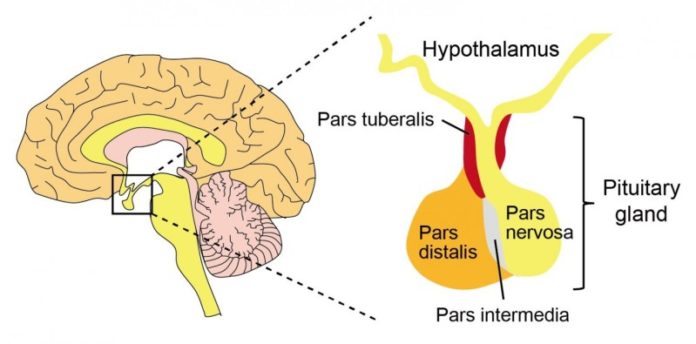
Through an extensive national and international collaboration, Professor Takashi Yoshimura and Dr. Keisuke Ikegami (currently at Kinki University) at the Institute of Transformative Bio-Molecules (ITbM) of Nagoya University, Prof. Samuel Refetoff of the University of Chicago and co-workers have uncovered the mechanism of how thyrotropin, the thyroid stimulating hormone (TSH), which triggers two different functions, manages to avoid functional crosstalk when released into the bloodstream.
TSH is a glycoprotein (a protein that contains carbohydrate) secreted from two parts of the pituitary gland in the brain. Previous studies have shown that TSHs secreted from both regions of the pituitary gland have the same protein structure. TSH has been known for a long time to be a hormone secreted from the front of the pituitary gland (pars distalis) that stimulates the thyroid gland to synthesize and secrete thyroid hormones, which in turn regulates metabolism and growth. On the other hand, Yoshimura’s group has uncovered the novel function of TSH secreted from the stalk of the pituitary gland (pars tuberalis) that acts on the hypothalamus as a spring calling hormone, which sends information on seasonal changes. Up till now, it has been a mystery on how these two TSHs manage to distinctively trigger biologically significant processes without interfering with one another.
The study, published online on October 30, 2014 in the journal, Cell Reports, reports a new finding where the same molecule imparts different functions without cross activity through tissue-specific glycosylation (attachment of sugars) and subsequent recognition by the immune system. This new paradigm is expected to be of high significance in the fields of both glycobiology and immunology as well as contribute towards the understanding of diseases related to the synthesis and secretion of TSHs.
Many organisms adapt to seasonal changes by detecting changes in day length. Examples of physiological activities regulated by changes in day length, include seasonal breeding, bird migration, hibernation of bears and wool shedding of sheep. The mechanism on how organisms sense spring has been a long-term mystery. Fortunately in 2008, Yoshimura and co-workers have finally elucidated the mechanism on how mammals sense seasonal changes. They identified that upon the arrival of spring (i.e. longer day length), TSH secreted from the pars tuberalis (PT-TSH) in the pituitary gland acts as a spring calling hormone and sends information on seasonal changes to the hypothalamus in the brain. On the other hand, it has been known for a long time that TSH is a hormone secreted by the pars distalis (PD-TSH) that stimulates the thyroid gland to synthesize and secrete thyroid hormones, which regulate growth and metabolism in the body. Hormones affect the target organ through circulation in the bloodstream. “It has been a great mystery on how the activities of TSHs were being differentiated. Initially, it has been suggested that TSHs arising from the pars tuberalis and pars distalis were being regulated differently at each source,” says Prof. Takashi Yoshimura who led the research. “From our investigations on knock-out mice, we found that PD-TSH was being regulated by the thyrotropin-releasing hormone (TRH) secreted by the hypothalamus, whereas PT-TSH was not controlled by TRH but was being controlled by a hormone called melatonin, which is a hormone secreted by the pineal gland during the night.”
Upon studying the structures of PT-TSH and PD-TSH by MALDI mass spectrometry analysis, it was discovered that they both shared the same protein structure but had different types of carbohydrate chains attached to them. PD-TSH had sulfated bi-antennary carbohydrate chains, which could be easily metabolized. On the other hand, PT-TSH had sialylated multi-branched carbohydrate chains, which could form stable macro-TSH complexes with immunoglobulin and albumin present in the blood. “Since starting this research in 2008, we had to revisit our hypotheses many times, and finally found that tissue-specific glycosylation occurred in the pars tuberalis and pars distalis of the pituitary gland, which differentiates each of their TSH to prevent cross activity,” explains Prof. Yoshimura. “Interestingly, the bioactivities of PT-TSH and PD-TSH themselves showed no difference. Meanwhile, PT-TSH loses its bioactivity in the bloodstream by forming stable macro-TSH complexes, and thus, does not act upon the thyroid gland.”
Glycosylation, the covalent addition of oligosaccharides to proteins, is a post-translational modification that increases the diversity of the proteome. Although the fundamental importance of glycosylation has been recognized in recent years, its physiological role has remained unclear. This study illustrates the first example of the involvement of tissue-specific glycosylation in preventing functional crosstalk between signaling molecules. Prof. Yoshimura says, “As the genome is finite, organisms use the same protein to serve multiple functions. Through our studies, we were able to uncover the elegant strategy of the organism, where tissue-specific glycosylation and subsequent immune recognition is used to impart two distinctive functions on a single hormone. We envisage that this new paradigm will be of great significance to researchers in a variety of fields including glycobiology, immunology, endocrinology, physiology, and neuroscience, along with contribution towards agriculture (animal reproduction) and human health.”
Story Source:
The above story is based on materials provided by Institute of Transformative Bio-Molecules (ITbM), Nagoya University. Note: Materials may be edited for content and length.
Journal Reference:
- Keisuke Ikegami, Xiao-Hui Liao, Yuta Hoshino, Hiroko Ono, Wataru Ota, Yuka Ito, Taeko Nishiwaki-Ohkawa, Chihiro Sato, Ken Kitajima, Masayuki Iigo, Yasufumi Shigeyoshi, Masanobu Yamada, Yoshiharu Murata, Samuel Refetoff, Takashi Yoshimura. Tissue-Specific Posttranslational Modification Allows Functional Targeting of Thyrotropin. Cell Reports, 2014; DOI: 10.1016/j.celrep.2014.10.006
